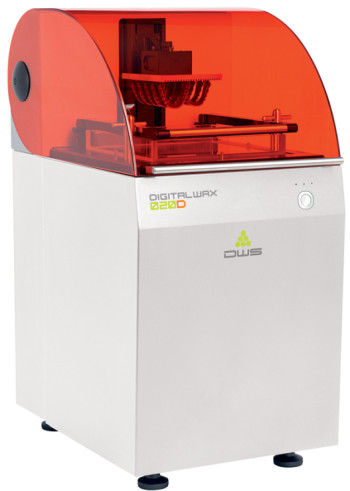
Italian firm DWS has been manufacturing vat photopolymerization 3D printers since 2005, first with the name Next Factory, and then as Digital Wax Systems (DWS) starting in 2007.
With a wide variety of stereolithography (SLA) systems and several digital light processing (DLP) printers priced between USD$11,300 and $282,700 (EUR€10,000 and €250,000), the company has over 30 patents associated with its technology.
With a print volume of 130 mm × 130 mm × 90 mm, the DigitalWax 020D is a smaller SLA 3D printer marketed toward the dental industry, hence the “D” in its name. Meant for less-sizable dental labs, the machine is desktop sized and designed to quickly 3D print accurate models with limited manual intervention.
The 020D system can achieve layer thicknesses as fine as 0.01 mm to 0.10 mm, making it ideal for producing objects with very fine features that may be necessary for dental procedures. For instance, when combined with intraoral, impression or stone model scanning, the printer can be used to 3D print crowns or orthodontic surgical guides.
To do so, the 020D can 3D print with the complete portfolio of DWS materials, including castable resins for 3D printing detailed bridges or partial frameworks for lost-wax casting, as well as transparent resins for 3D printing surgical guides. Digital impression models can also be printed using the RD resin series, while the Temporis line is meant for 3D printing temporary crowns and bridges. Soft tissue models, such as gingival masks, can be 3D printed with the “gingiva-like” (GL) resin.
How the DigitalWax 020D Works
First commercialized in 1988, SLA is the earliest form of 3D printing technology, directing ultraviolet lasers at mirrors that bounce the light onto a vat of photopolymer resin. The 020D features a solid-state BluEdge BE-1500C laser, designed by DWS Research & Development Centre, and a galvanometer scanner. This scanner bounces light from directly underneath a transparent vat, curing resin along the X- and Y-axes, while the printbed onto which the object is fabricated lifts up layer by layer in the Z-axis.
The 020D is capable of 10 micron (0.1 mm) resolution on all axes and scanning the X- and Y-axes at a quick rate of 5100 mm per second. Though SLA may not be as fast as other photopolymerization processes, such as DLP, it is much faster than extrusion processes, and the use of a laser allows for very fine details and a smoother finish compared to extrusion.
Once a print is complete, it must be further cured with UV light in a separately sold device to further strengthen the print. DWS sells two such systems, UV Curing Unit “S” and “M.” Photopolymers, however, do not have an infinite shelf life, and prints may eventually degrade over time, particularly when exposed to sunlight.
Read more at ENGINEERING.com

